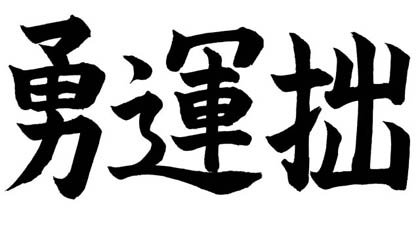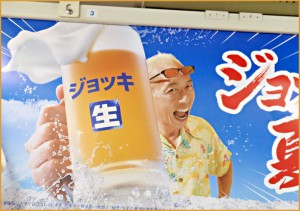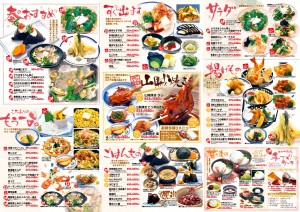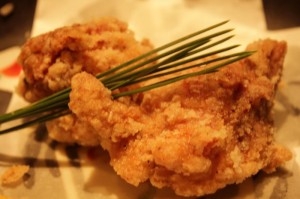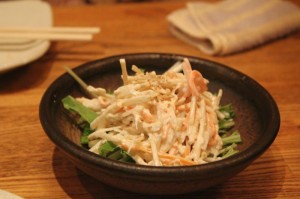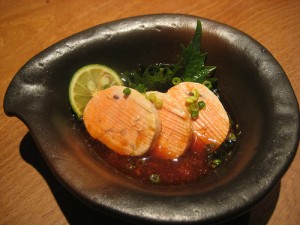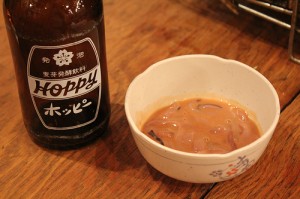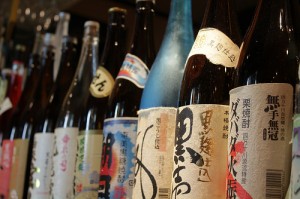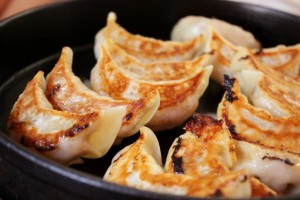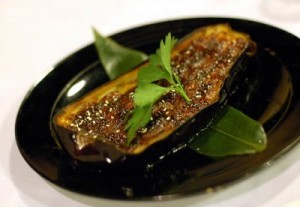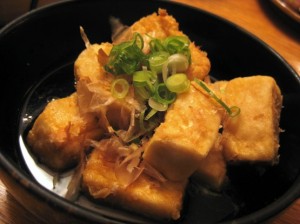Ichi-go ichi-e / 一期一会
 Ichi-go ichi-e literally “one time, one meeting” is a Japanese term that is originally associated with the Japanese tea ceremony. It is also used in many other sphere such as martial art or day to day life. Ichi-go ichi-e also translated by “one chance in a lifetime” remind us that each meeting whether a tea ceremony, a martial art shiai or good time with friends is unique. The term in Budō, in a life-or-death situation, also means that there will be no chance to “try again”. Even though techniques may be attempted many times in the dojo, each should be seen as a singular and decisive event.
Ichi-go ichi-e literally “one time, one meeting” is a Japanese term that is originally associated with the Japanese tea ceremony. It is also used in many other sphere such as martial art or day to day life. Ichi-go ichi-e also translated by “one chance in a lifetime” remind us that each meeting whether a tea ceremony, a martial art shiai or good time with friends is unique. The term in Budō, in a life-or-death situation, also means that there will be no chance to “try again”. Even though techniques may be attempted many times in the dojo, each should be seen as a singular and decisive event.
Despite this introduction I will not be focusing on Iaido this time but on another passion of mine which is good Food and Sake. Taking into account that the pleasure of eating good food only reaches its maximum when shared with friends in a relax and authentic environment and matching all those requirements plus the Japanese touch: Let’s talk about Izakaya …
“I took two friends to one of my favourite izakaya on the outskirts of Tokyo, a boisterous, working-class establishment run by a jolly staff of mature woman. We sat at a large table beside a tired-looking elderly businessman who was reading a book over his beer, and ordered among other dishes, breaded pork and onion skewers, horse mackerel sashimi, grated daikon radish with baby sardines, and potato salad. After an hour or so, the businessman said hello, and we asked what he was reading. He raised his book to show us. It was Henry V, in Japanese. He beamed and said “But who I really like is Falstaff!” referring to the gluttonous, comic drunk of Henry IV. Then he raised his hand in a drinking gesture and said “Glug,glug,glug”. On the face of it, it was an unremarkable incident. But somehow this weary corporate employee with his enthusiasm for Shakespeare and the drive to enjoy it in a noisy neighbourhood pub changed the complexion of the room. It was the sort of thing that often happens at the Japanese pub, a case of ichigo ichie.”
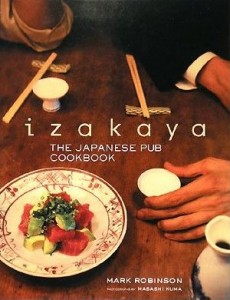 This excerpt was taken from one of the few English book focusing on Japanese pub “Izakaya” written by Mark Robinson. The book is presented as a cookbook but is more of a guided tour of Mark’s favourite Izakaya listing some of their signature dishes, some of them, it is true, being quite hard to reproduce without access to fresh Japanese ingredients. Through the reading of this book and the beautiful pictures took by Masashi Kuma you can really feel and share Mark’s passion for the vibes of evenings spent in Izakaya.
This excerpt was taken from one of the few English book focusing on Japanese pub “Izakaya” written by Mark Robinson. The book is presented as a cookbook but is more of a guided tour of Mark’s favourite Izakaya listing some of their signature dishes, some of them, it is true, being quite hard to reproduce without access to fresh Japanese ingredients. Through the reading of this book and the beautiful pictures took by Masashi Kuma you can really feel and share Mark’s passion for the vibes of evenings spent in Izakaya.
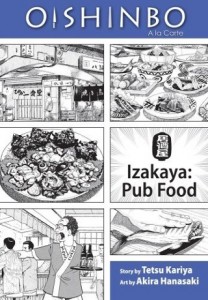 Another interesting food oriented manga to discover is the Oishimbo (美味しんぼ) series including the volume #7 focusing on Izakaya. The series depicts the adventures of culinary journalist Shirō Yamaoka and his partner Yūko Kurita. In this volume of Oishinbo, Yamaoka and Kurita investigate classic izakaya foods such as edamame and yakitori, devise new dishes to add to the menu of an old shop, and discover how the concept of “play” is essential to the enjoyment of food.
Another interesting food oriented manga to discover is the Oishimbo (美味しんぼ) series including the volume #7 focusing on Izakaya. The series depicts the adventures of culinary journalist Shirō Yamaoka and his partner Yūko Kurita. In this volume of Oishinbo, Yamaoka and Kurita investigate classic izakaya foods such as edamame and yakitori, devise new dishes to add to the menu of an old shop, and discover how the concept of “play” is essential to the enjoyment of food.
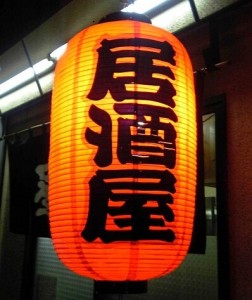 Izakaya’s most common translation is Japanese “Pub” even if it is not very adequate to describe the experience. Izakaya originated from sake shops allowing local customers to sit to drink. As time goes by Izakaya started to serve small dishes to accompany the drinks. In Japan Izakaya are most of the time indicated in the street by the famous akachōchin (red lantern).
Izakaya’s most common translation is Japanese “Pub” even if it is not very adequate to describe the experience. Izakaya originated from sake shops allowing local customers to sit to drink. As time goes by Izakaya started to serve small dishes to accompany the drinks. In Japan Izakaya are most of the time indicated in the street by the famous akachōchin (red lantern).
From a 2009 report there was around 20.000 Izakaya establishment in Japan. The Japanese modern city lifestyle especially for salary man (working hours, public transport) make them by far the top of the “Outside of the house” meal consumer. In such conditions Izakaya are as much a place of consumption than socialisation where latest news, difficulties at the office, family news are discussed. Such after work, celebration meeting has become a real social phenomenon and is often referred as Nomikai.
“Neither restaurant nor bar, The Izakaya is more than a place where you can share delicious food and relaxing drink. It is a community hub with a cast of characters and ongoing narratives. The customers will order small-dish delicacies throughout the evening calling out orders as the mood takes them. And as the evening progresses and energy levels rise, you will hear straight talk and the uttering of hard truths that won’t ordinarily be spoken. In short, at the Izakaya, people are more themselves.”
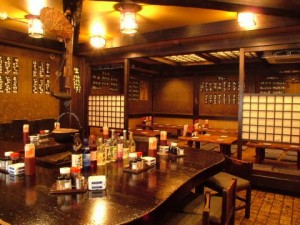 Entering an unfamiliar Izakaya can be daunting due to the fact that generally it is hard to have a look inside with their frosted glass window (or no window at all) and noren obscuring the entry door. But you have nothing to loose stepping into a new adventure. As soon as you have sit down one of the staff will immediately proffer a hot handtowel and ask for your drink order. What might be seen as a pushy behaviour – asking your order when you are barely seated – is a custom which stems from the fact that izakaya customers know what they want to drink and they want it straight away.
Entering an unfamiliar Izakaya can be daunting due to the fact that generally it is hard to have a look inside with their frosted glass window (or no window at all) and noren obscuring the entry door. But you have nothing to loose stepping into a new adventure. As soon as you have sit down one of the staff will immediately proffer a hot handtowel and ask for your drink order. What might be seen as a pushy behaviour – asking your order when you are barely seated – is a custom which stems from the fact that izakaya customers know what they want to drink and they want it straight away.
What is great with Izakaya is that they accord equal weight to food and drink. It is accepted and even expected that you arrive with a thirst as good as your appetite. Most customers will begin with a beer using the “Toriaezu biiru” quote meaning that you will already start with a beer. Beer “refreshes” the throat for what is to come and will buy you time to consider what to order and what to drink with it. Sometimes the menu are laying on the table or are simply displayed on the walls. Food and drink are ordered throughout the course of the session as desired. Unlike other Japanese styles of eating, food items are usually shared by everyone at the table, dishes being generally inexpensive and relatively small in size.
So what can you find on an typical Izakaya menu ? Sake (generic term for alcohol) of course with a good list of beer, shochu and nihonshu.
– Beer Generaly nama-biruu (draft beer) server in Jokki (half pint glasses).
– Hoppy (ホッピ) is a drink that contains about 0.8 percent of alcohol. It is often added to shochu and is a popular item at Izakaya, especially within the suburban old town area.
– Shochu (焼酎) is a Japanese distilled beverage containing around 25% alcohol. Typically distilled from barley, sweet potatoes, rice and many other ingredients.
– Nihonshu (日本酒) often called sake and wrongly translated in rice wine. Nihonshu being in reality made through a brewing process more like that of beer.
Best dishes to accompany sake includes:
– Edamame (枝豆) Salted soybeans
– Tsukemono (漬物) Japanese pickles including Asazuke (浅漬け)
– Shiokara/Kirikomi (塩辛) various marine animals heavily salted, with fermented viscera. Shiokara is part of the Chinmi recipe (珍味) literally “rare taste”
Other typical Izakaya food will include:
– Tori karaage
– Yaki nasu (Grilled eggplant)
– Agedashi tofu
– Gyoza
– Sliced tomatoes
– Grilled fish and Kushiyaki (grilled skewers)
– Potato salada
– Onigiri grilled or stuffed with shake, umeboshi or mentaiko
And many many more …
The intention of this post was to tempt your taste buds and broaden Japanese cuisine beyond the classic sushi/sashimi horizon. I hope I succeeded and that as soon you finished reading this, you will plan a dinner out with friends to your favourite restaurant – preferably an Izakaya of course – and enjoy good sake and delicious food.
Bon appetit
M. “Born Hungry”
Posted: April 5th, 2012 under Article.
Tags: Ichigo Ichie, Izakaya


